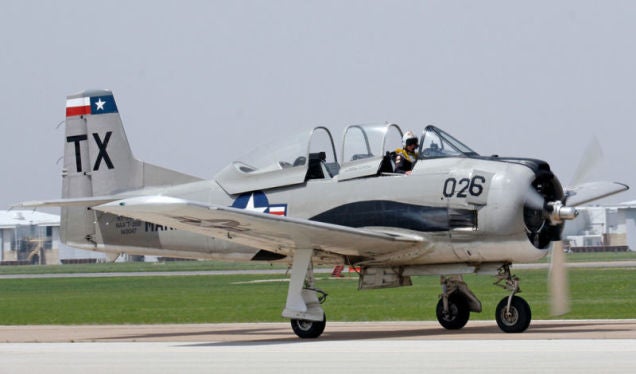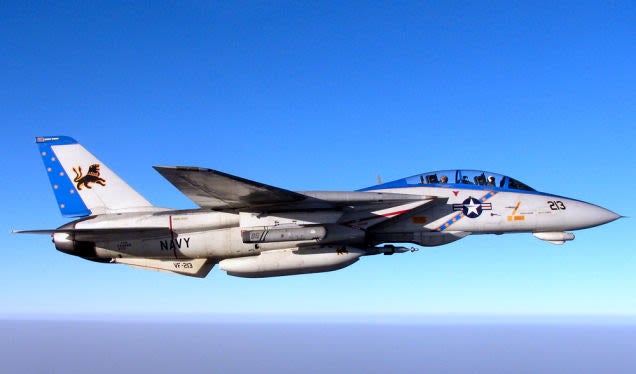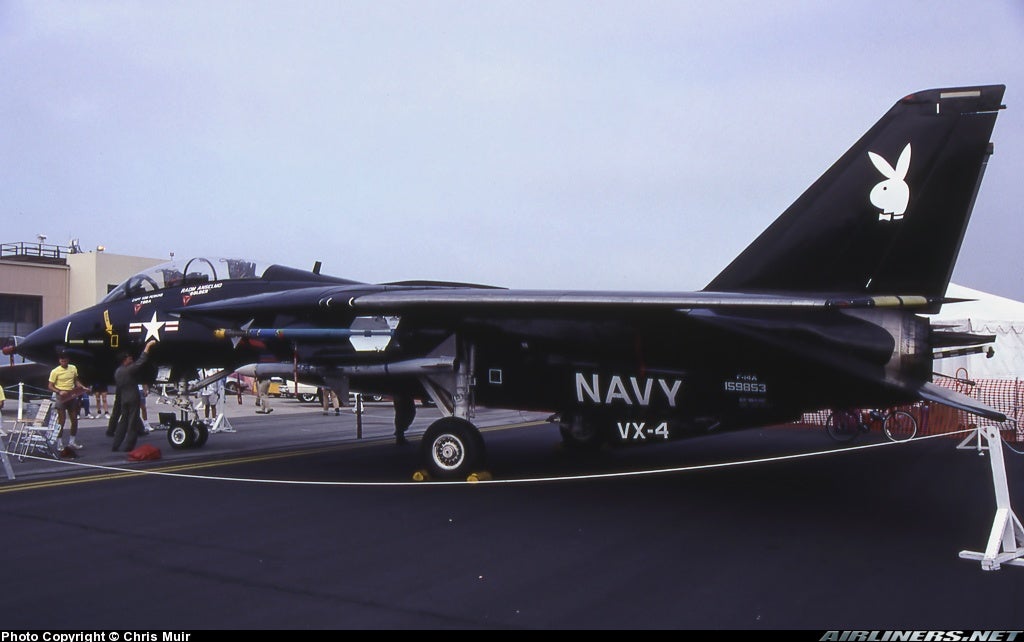 "ttyymmnn" (ttyymmnn)
"ttyymmnn" (ttyymmnn)
09/25/2018 at 12:35 • Filed to: wingspan, planelopnik history, Planelopnik
 3
3
 13
13
 "ttyymmnn" (ttyymmnn)
"ttyymmnn" (ttyymmnn)
09/25/2018 at 12:35 • Filed to: wingspan, planelopnik history, Planelopnik |  3 3
|  13 13 |
!!! UNKNOWN CONTENT TYPE !!!
Welcome to
This Date in Aviation History
, getting of you caught up on milestones, important historical events and people in aviation from September 22 through September 25.
!!! UNKNOWN CONTENT TYPE !!!

(Tim Shaffer)
September 24, 1949 – The first flight of the North American T-28 Trojan . The career of any military pilot begins with primary flight training carried out in a two-seat trainer, with one seat for the student and one for the instructor. Since before WWII, most American pilots flew the !!!error: Indecipherable SUB-paragraph formatting!!! , one of aviation history’s truly great airplanes, and it became the primary trainer for no less than 61 nations and ultimately served for 60 years. But even a great plane like the Texan would need to be replaced one day. When that time came, though, the US military didn’t look for just a trainer. They hoped to adopt an aircraft that would also work well in the close air support (CAS) and ground attack roles.

A US Navy T-28B Trojan of Training Squadron VT-2 over Florida in 1973. (US Navy)
Based on the success of the T-6, the US Navy and Air Force once again turned to !!!error: Indecipherable SUB-paragraph formatting!!! , and the aircraft the storied company came up with proved to be every bit as effective as the one it was meant to replace. Like the Texan, the Trojan was a simple, rugged, straight-wing aircraft. It was powered by a !!!error: Indecipherable SUB-paragraph formatting!!! nine-cylinder supercharged radial engine, the same one that powered many of the great warplanes of WWII such as the !!!error: Indecipherable SUB-paragraph formatting!!! , the !!!error: Indecipherable SUB-paragraph formatting!!! , and a host of other military aircraft and helicopters. The engine provided a top speed of 343 mph with a climb rate of 4,000 feet per minute, and the two pilots were housed under a frameless canopy that provided excellent visibility for both instructor and student.

A pair of South Vietnamese Air Force T-28C Trojans over the Vietnamese coastline in 1962. (US Air Force)
The T-28A first entered service with the US Air Force, and was quickly adopted by the US Navy and US Marine Corps in two variants: the T-28B, which was similar to the Air Force version but with a more powerful engine, and the T-28C, which was designed for carrier operations with a smaller propeller and added arrester hook. Designed also as a potent ground attack platform, units of the South Vietnamese Air Force flew an armed variant of the Trojan known as the T-28D Nomad for the !!!error: Indecipherable SUB-paragraph formatting!!! (COIN) role, as well as reconnaissance, search and rescue, and forward air control. For dedicated ground attack missions, the AT-28D provided a sturdy, flexible platform with six underwing hardpoints that could carry bombs, rockets or napalm for ground attack missions, and was also fitted with an ejection seat. Trojans also served as an armed escort for attacks by !!!error: Indecipherable SUB-paragraph formatting!!! or attack helicopters.

T-28A warbird performing at Naval Air Station Joint Reserve Base Fort Worth. (Tim Shaffer)
While the Air Force phased the Trojan out of service by the 1960s, it continued to serve the Navy and Marines well into the 1980s before being replaced by the turboprop-powered
!!!error: Indecipherable SUB-paragraph formatting!!!
. And, like its predecessor, the Trojan was widely exported, serving a total of twenty-eight international customers, with nearly 2,000 produced from 1950-1957. The last T-28 was retired by the US Navy in 1984, but the aircraft served for another ten years with the Philippine Air Force, and privately-owned Trojans remain a popular performer on the air show circuit.
!!! UNKNOWN CONTENT TYPE !!!
Short Takeoff
!!! UNKNOWN CONTENT TYPE !!!

(US Navy)
September 22, 2006 – The Grumman F-14 Tomcat is retired by the US Navy.
Developed after the the US Navy’s rejection of the
!!!error: Indecipherable SUB-paragraph formatting!!!
carrier-based interceptor, the F-14 became the Navy’s primary fighter, though it retained the engines, weapons system and variable geometry wing of its unsuccessful predecessor. The Tomcat entered service with the US Navy in 1974, replacing the
!!!error: Indecipherable SUB-paragraph formatting!!!
, and served as the Navy’s principal air superiority fighter while also performing fleet defense and reconnaissance missions. With the arrival of the
!!!error: Indecipherable SUB-paragraph formatting!!!
in 1999, the Tomcat was phased out, with its official retirement taking place in 2006 after 32 years of service. Many Tomcats reside in museums, but retired operational F-14s were scrapped by the US government to prevent their parts being obtained by Iran, the sole export customer for the Tomcat before the
!!!error: Indecipherable SUB-paragraph formatting!!!
toppled the Shah of Iran.
!!! UNKNOWN CONTENT TYPE !!!

(Imperial War Museum)
September 23, 1938 – The first flight of the Supermarine Sea Otter,
an amphibian aircraft developed for the Royal Navy and Royal Air Force before WWII and the last biplane to be flown by either service. The Sea Otter was a development of the earlier
!!!error: Indecipherable SUB-paragraph formatting!!!
, with the principal difference being the placement of a single
!!!error: Indecipherable SUB-paragraph formatting!!!
radial engine in the center of the upper wing in a puller configuration rather than between the wings as a pusher. The Sea Otter entered service in 1942 and carried out air-sea rescue missions and maritime reconnaissance, while postwar aircraft flew small numbers of passengers and cargo. Just under 300 were built before the end of the war halted production.
!!! UNKNOWN CONTENT TYPE !!!

Young in 1963 as a member of the Gemini 3 crew (NASA)
September 24, 1930 – The birth of John Young, an American aeronautical engineer, US Naval Aviator, test pilot, and astronaut. Young began flying with the US Navy as a helicopter pilot in 1954 before transferring to jets, and joined NASA in 1962 as a member of Astronaut Group 2. During his time with the space agency, Young made six space flights, including the first manned !!!error: Indecipherable SUB-paragraph formatting!!! mission. In 1969 he became the first man to orbit the Moon alone during !!!error: Indecipherable SUB-paragraph formatting!!! , drove the !!!error: Indecipherable SUB-paragraph formatting!!! on the Moon during !!!error: Indecipherable SUB-paragraph formatting!!! in 1972, and is one of only three people who have flown to the Moon twice. Young is also the only person to have piloted four different classes of spacecraft, including the first flight of the !!!error: Indecipherable SUB-paragraph formatting!!! in 1981. Young’s retirement from NASA in 2004 marked the end of the longest career of any NASA astronaut.
!!! UNKNOWN CONTENT TYPE !!!

Doolittle sits in the rear cockpit of the NY-2. The hood that enclosed the cockpit is retracted. (Smithsonian)
September 4, 1929 – Lieutenant James H. “Jimmy” Doolittle makes the first blind flight using only instruments. Flying a !!!error: Indecipherable SUB-paragraph formatting!!! with instruments that included sensitive altimeter, a directional gyro developed by the Sperry company, and a radio range finder, Doolittle, along with safety officer Lt. Benjamin Kelsey in the front cockpit, took off from Mitchel Field in New York and flew a prescribed course which covered 20 miles and lasted 15 minutes. From takeoff to landing, Doolittle was underneath a hood in the rear cockpit and was flying completely blind. The flight proved the capabilities of the new instruments, and opened a new era of flight safety where pilots could rely on instruments rather than instincts or “seat of the pants” flying.
!!! UNKNOWN CONTENT TYPE !!!

(US Navy; UK Government)
September 24, 1918 – US Navy Lt. David Ingalls becomes the first US Navy fighter ace. Ingalls enlisted in March 1917 as Naval Aviator No. 85 and was sent to Europe six months later attached to !!!error: Indecipherable SUB-paragraph formatting!!! , where he flew a !!!error: Indecipherable SUB-paragraph formatting!!! from a base in Dunkirk in northern France. With six credited victories by the end of the war, Ingalls was the first fighter ace in US Navy history and the Navy’s only ace of WWI. For his service, Ingalls received the US Navy !!!error: Indecipherable SUB-paragraph formatting!!! , the British !!!error: Indecipherable SUB-paragraph formatting!!! and the French !!!error: Indecipherable SUB-paragraph formatting!!! . Following the war, Ingalls became a director of !!!error: Indecipherable SUB-paragraph formatting!!! and assisted !!!error: Indecipherable SUB-paragraph formatting!!! with charting eastern air routes for Pan Am.
!!! UNKNOWN CONTENT TYPE !!!

(US Air Force)
September 25, 2015 – The first flight of the Boeing KC-46 Pegasus, the newest aerial refueling and strategic airlifter slated to enter service with the US Air Force in late 2018 or early 2019. In 2011, the Pegasus was announced as the winner of the Air Force !!!error: Indecipherable SUB-paragraph formatting!!! competion over a Northrop Grumman/Airbus offering in a protracted and often acrimonious debate over which aircraft would replace 100 older !!!error: Indecipherable SUB-paragraph formatting!!! . The Pegasus is based on the !!!error: Indecipherable SUB-paragraph formatting!!! widebody airliner and will have seating for up to 114 people or 65,000 pounds of cargo and will be capable of transferring over 207,000 pounds of fuel. The Air Force has placed an order for a total of 36 aircraft, and the tankers will be based at McConnell Air Force Base in Kansas.
!!! UNKNOWN CONTENT TYPE !!!

(Hans Wendt)
September 25, 1978 – The midair collision of Pacific Southwest Airlines Flight 182 and a private plane over San Diego. On the day of the collision, PSA Fight 182, a !!!error: Indecipherable SUB-paragraph formatting!!! (N533PS), was approaching San Diego’s Lindbergh Field (now San Diego International Airport) when it collided with a !!!error: Indecipherable SUB-paragraph formatting!!! . The crew of the 727 had been alerted to the presence of the Cessna, but had lost sight of it and failed to notice when it made an unauthorized change of course. The pilot of the Cessna was under a hood practicing !!!error: Indecipherable SUB-paragraph formatting!!! (ILS) approaches, but his instructor had no limitations on his vision and failed to see the 727. Air traffic control detected a conflict alert but did not warn the aircraft since they believed that they could see each other. The two aircraft came down in a residential area, killing 142 passengers and nine people on the ground. Following a similar !!!error: Indecipherable SUB-paragraph formatting!!! , the FAA mandated that !!!error: Indecipherable SUB-paragraph formatting!!! (TCAS) be installed in all commercial airliners flying in US airspace.
!!! UNKNOWN CONTENT TYPE !!!

(Andre Wadman)
September 25, 1945 – The first flight of the de Havilland Dove,
a short-haul passenger plane that was designed as a feeder to larger airports and one of the most successful designs to come out of the
!!!error: Indecipherable SUB-paragraph formatting!!!
in their search for a domestically produced British airliner following WWII. The Dove was a monoplane successor to the pre-WWII
!!!error: Indecipherable SUB-paragraph formatting!!!
biplane and had accommodations for eight passengers. De Havilland produced 542 Doves from 1946 to 1967, and it entered service in 1946, with the first aircraft purchased by Argentina. The Dove was widely exported, serving airlines around the world, and remains in limited service today.
!!! UNKNOWN CONTENT TYPE !!!
Connecting Flights
!!! UNKNOWN CONTENT TYPE !!!
!!! UNKNOWN CONTENT TYPE !!!
!!! UNKNOWN CONTENT TYPE !!!
!!! UNKNOWN CONTENT TYPE !!!
!!! UNKNOWN CONTENT TYPE !!!
If you enjoy these Aviation History posts, please let me know in the comments. And if you missed any of the past articles, you can find them all at
!!!error: Indecipherable SUB-paragraph formatting!!!
. You can also find more stories about aviation, aviators and airplane oddities at
!!!error: Indecipherable SUB-paragraph formatting!!!
.
!!! UNKNOWN CONTENT TYPE !!!
 RamblinRover Luxury-Yacht
> ttyymmnn
RamblinRover Luxury-Yacht
> ttyymmnn
09/25/2018 at 12:56 |
|
Sorry, don’t have any anecdotes on any of these items today. I will note, however, that the Dove’s nosegear is totally bonkers. What the hell, man.
 ttyymmnn
> RamblinRover Luxury-Yacht
ttyymmnn
> RamblinRover Luxury-Yacht
09/25/2018 at 12:59 |
|
I hadn’t noticed that, but yeah, it’s crazy.
 RamblinRover Luxury-Yacht
> ttyymmnn
RamblinRover Luxury-Yacht
> ttyymmnn
09/25/2018 at 13:01 |
|
It’s probably nearly immune to ground looping, but the support beam for that has got to stick
right through where a sane person would have put the radar.
 TheRealBicycleBuck
> RamblinRover Luxury-Yacht
TheRealBicycleBuck
> RamblinRover Luxury-Yacht
09/25/2018 at 13:04 |
|
The cockpit isn’t an award-winner either.
 RamblinRover Luxury-Yacht
> TheRealBicycleBuck
RamblinRover Luxury-Yacht
> TheRealBicycleBuck
09/25/2018 at 13:08 |
|
1945 = gotta have room for what the Stylish Pilot Is Wearing. Airline cap, fedora, whatever.

Plus, it tapers back down at about the point the cross-section increases for the wings, so it’s only mostly an aerodynamic bad idea.
 user314
> ttyymmnn
user314
> ttyymmnn
09/25/2018 at 13:09 |
|
I feel the need...




 Just Jeepin'
> ttyymmnn
Just Jeepin'
> ttyymmnn
09/25/2018 at 13:13 |
|
Air traffic control detected a conflict alert but did not warn the aircraft since they believed that they could see each other.
Shit like this pisses me off. Over 150 people dead because of stupid assumptions .
 TheRealBicycleBuck
> RamblinRover Luxury-Yacht
TheRealBicycleBuck
> RamblinRover Luxury-Yacht
09/25/2018 at 13:25 |
|
I think they had to bump the cockpit up to make room in the baggage area for their big coj ones.
 ttyymmnn
> user314
ttyymmnn
> user314
09/25/2018 at 13:32 |
|
Have you seen what is reported to be Maverick’s Super Hornet for the upcoming Top Gun sequel?

Also, that fourth image (illustration). I have that book! I bought it back in about 1982 (it’s ©1980). It’s a bit dated, but still has some very good information in it.

In fact, it’s so old that the the F/A-18 is listed
as the F-18, and only in an artist’s rendering of what it
might
look like. They do have a photo of the YF-18 prototype, though.

 ttyymmnn
> Just Jeepin'
ttyymmnn
> Just Jeepin'
09/25/2018 at 13:33 |
|
ass/u/me
 user314
> ttyymmnn
user314
> ttyymmnn
09/25/2018 at 13:42 |
|
Yeah, I saw that on I0 9 a while back; I can’t decide if it’s odd or not that Mav is still a captain at this point.
 ttyymmnn
> user314
ttyymmnn
> user314
09/25/2018 at 13:51 |
|
Probably got busted for one too many flybys of the tower.
 user314
> ttyymmnn
user314
> ttyymmnn
09/25/2018 at 14:02 |
|
Or he got caught up in Tailhook...